MERCEDES-BENZ SLK-Class 2001 R170 Owner's Manual
Manufacturer: MERCEDES-BENZ, Model Year: 2001, Model line: SLK-Class, Model: MERCEDES-BENZ SLK-Class 2001 R170Pages: 273
Page 141 of 273
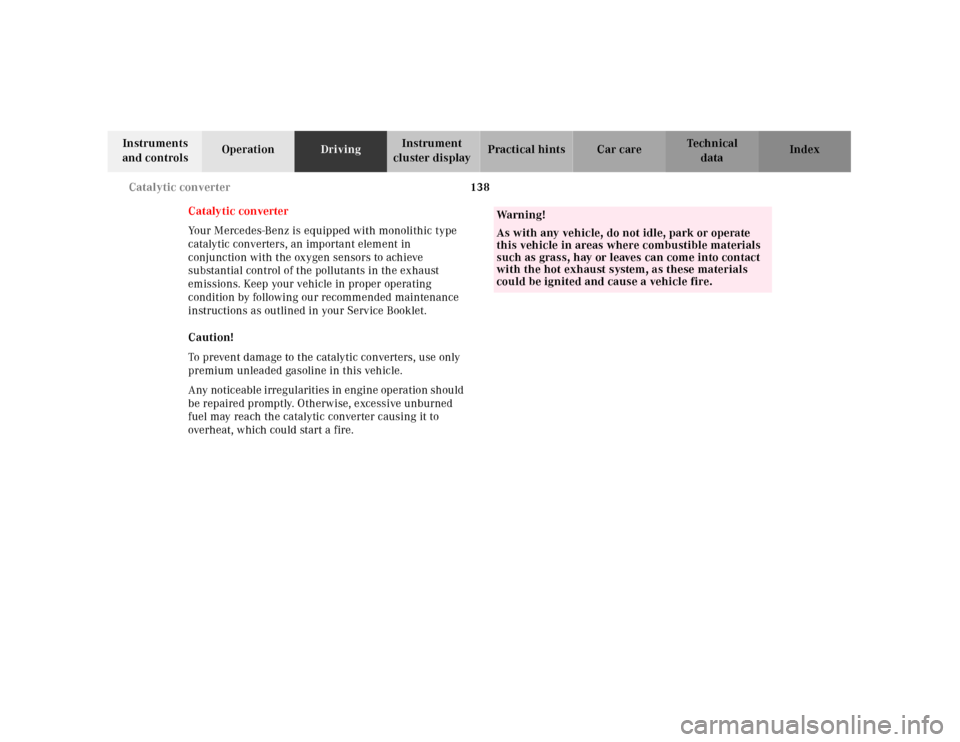
138 Catalytic converter
Te ch n ica l
data Instruments
and controlsOperationDrivingInstrument
cluster displayPractical hints Car care Index
Catalytic converter
Your Mercedes-Benz is equipped with monolithic type
catalytic converters, an important element in
conjunction with the oxygen sensors to achieve
substantial control of the pollutants in the exhaust
emissions. Keep your vehicle in proper operating
condition by following our recommended maintenance
instructions as outlined in your Service Booklet.
Caution!
To prevent damage to the catalytic converters, use only
premium unleaded gasoline in this vehicle.
Any noticeable irregularities in engine operation should
be repaired promptly. Otherwise, excessive unburned
fuel may reach the catalytic converter causing it to
overheat, which could start a fire.
Wa r n i n g !
As with any vehicle, do not idle, park or operate
this vehicle in areas where combustible materials
such as grass, hay or leaves can come into contact
with the hot exhaust system, as these materials
could be ignited and cause a vehicle fire.
Page 142 of 273
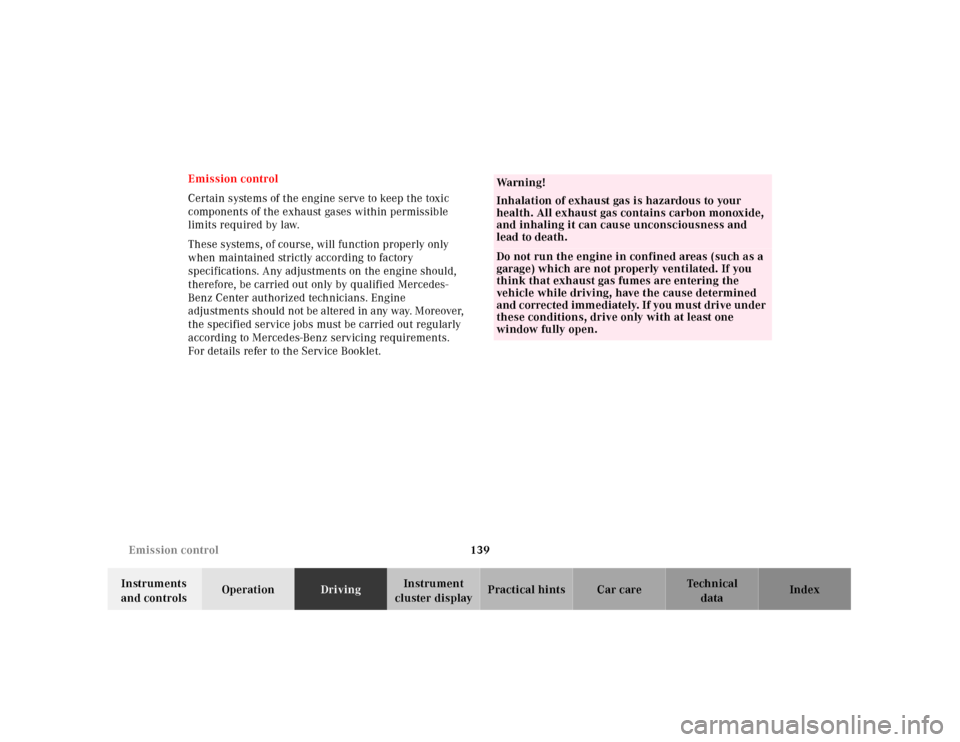
139 Emission control
Te ch n ica l
data Instruments
and controlsOperationDrivingInstrument
cluster displayPractical hints Car care Index Emission control
Certain systems of the engine serve to keep the toxic
components of the exhaust gases within permissible
limits required by law.
These systems, of course, will function properly only
when maintained strictly according to factory
specifications. Any adjustments on the engine should,
therefore, be carried out only by qualified Mercedes-
Benz Center authorized technicians. Engine
a dju stments sh ould not be a ltered in a ny way. M oreover,
the specified service jobs must be carried out regularly
according to Mercedes-Benz servicing requirements.
For details refer to the Service Booklet.
Wa r n i n g !
Inhalation of exhaust gas is hazardous to your
health. All exhaust gas contains carbon monoxide,
and inhaling it can cause unconsciousness and
lead to death.Do not run the engine in confined areas (such as a
garage) which are not properly ventilated. If you
think that exhaust gas fumes are entering the
vehicle while driving, have the cause determined
and c orrec ted imm ediately. If you m ust dri ve under
these conditions, drive only with at least one
window fully open.
Page 143 of 273
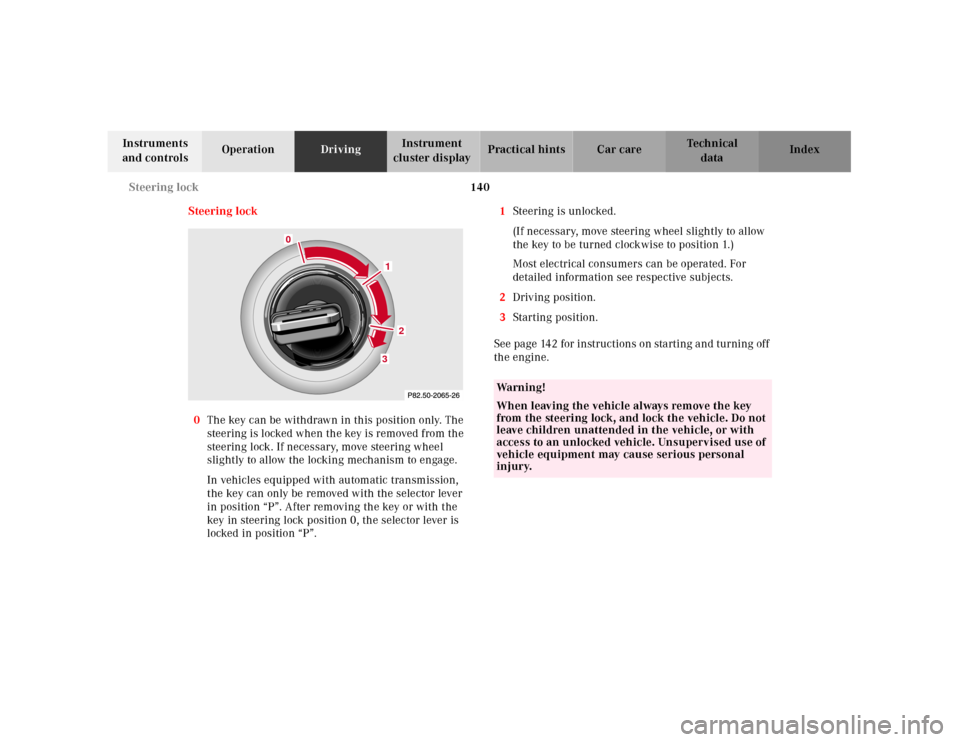
140 Steering lock
Te ch n ica l
data Instruments
and controlsOperationDrivingInstrument
cluster displayPractical hints Car care Index
Steering lock
0The key can be withdrawn in this position only. The
steering is l ocked w hen th e key is removed f rom th e
steering lock. If necessary, move steering wheel
slightly to allow the locking mechanism to engage.
In vehicles equipped with automatic transmission,
the key can only be removed with the selector lever
in position “P”. After removing the key or with the
key in steering lock position 0, the selector lever is
locked in position “P”.1Steering is unlocked.
(If necessary, move steering wheel slightly to allow
the key to be turned clockwise to position 1.)
Most electrical consumers can be operated. For
detailed information see respective subjects.
2Driving position.
3Starting position.
See page 142 for instructions on starting and turning off
the engine.
2
3
0
1
Wa r n i n g !
When leaving the vehicle always remove the key
from the steering lock, and lock the vehicle. Do not
leave children unattended in the vehicle, or with
access to an unlocked vehicle. Unsupervised use of
vehicle equipment may cause serious personal
injury.
Page 144 of 273
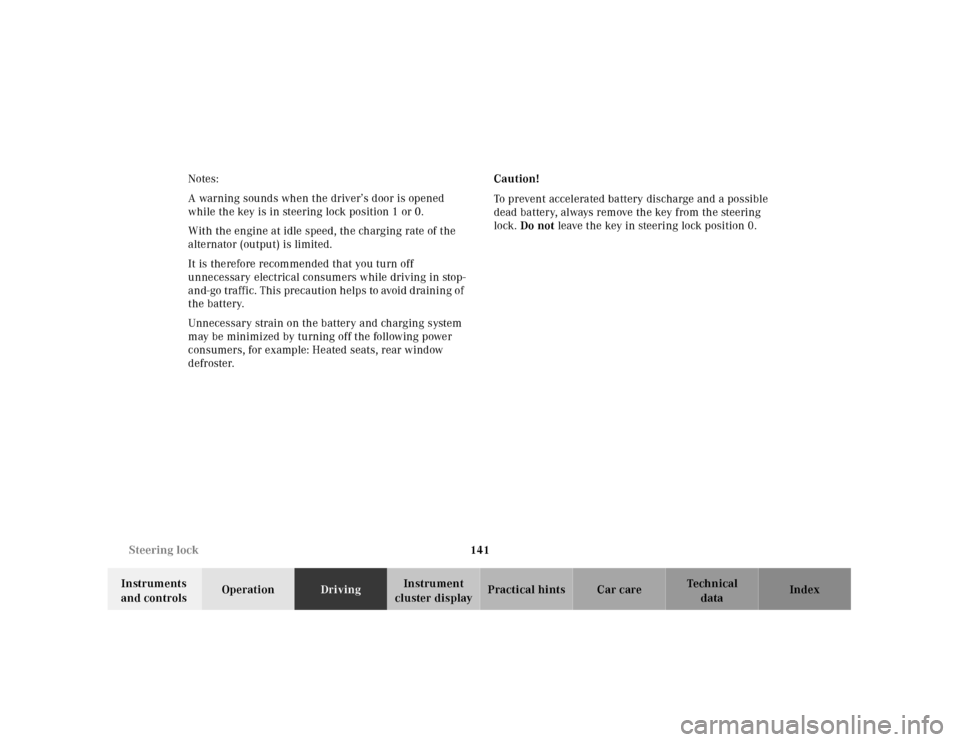
141 Steering lock
Te ch n ica l
data Instruments
and controlsOperationDrivingInstrument
cluster displayPractical hints Car care Index Notes:
A warning sounds when the driver’s door is opened
while the key is in steering lock position 1 or 0.
With the engine at idle speed, the charging rate of the
alternator (output) is limited.
It is therefore recommended that you turn off
unnecessary electrical consumers while driving in stop-
a nd-go tra ff ic. This preca ution h elps to avoid d ra ining of
the battery.
Unnecessary strain on the battery and charging system
may be minimized by turning off the following power
consumers, for example: Heated seats, rear window
defroster.Caution!
To prevent accelerated battery discharge and a possible
dead battery, always remove the key from the steering
lock. Do not leave the key in steering lock position 0.
Page 145 of 273
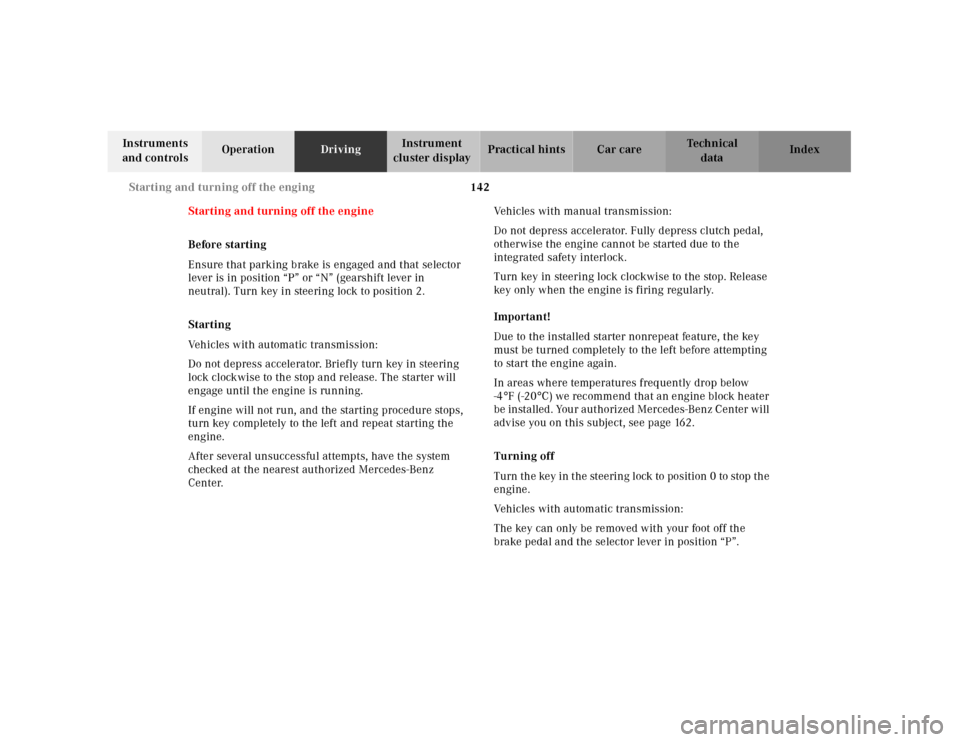
142 Starting and turning off the enging
Te ch n ica l
data Instruments
and controlsOperationDrivingInstrument
cluster displayPractical hints Car care Index
Starting and turning off the engine
Before starting
Ensure that parking brake is engaged and that selector
lever is in position “P” or “N” (gearshift lever in
neutral). Turn key in steering lock to position 2.
Starting
Vehicles with automatic transmission:
Do not depress accelerator. Briefly turn key in steering
lock clockwise to the stop and release. The starter will
engage until the engine is running.
If engine will not run, and the starting procedure stops,
turn key completely to the left and repeat starting the
engine.
After several unsuccessful attempts, have the system
checked at the nearest authorized Mercedes-Benz
Center.Vehicles with manual transmission:
Do not depress accelerator. Fully depress clutch pedal,
otherwise the engine cannot be started due to the
integrated safety interlock.
Turn key in steering lock clockwise to the stop. Release
key only when the engine is firing regularly.
Important!
Due to the installed starter nonrepeat feature, the key
must be turned completely to the left before attempting
to start the engine again.
In areas where temperatures frequently drop below
-4°F(-20°C) we rec omm end tha t a n e ng ine bl ock h eater
be insta lled . You r a ut horized Mercedes-Benz Center will
advise you on this subject, see page 162.
Turning off
Turn the key in the steering lock to position 0 to stop the
engine.
Vehicles with automatic transmission:
The key can only be removed with your foot off the
brake pedal and the selector lever in position “P”.
Page 146 of 273
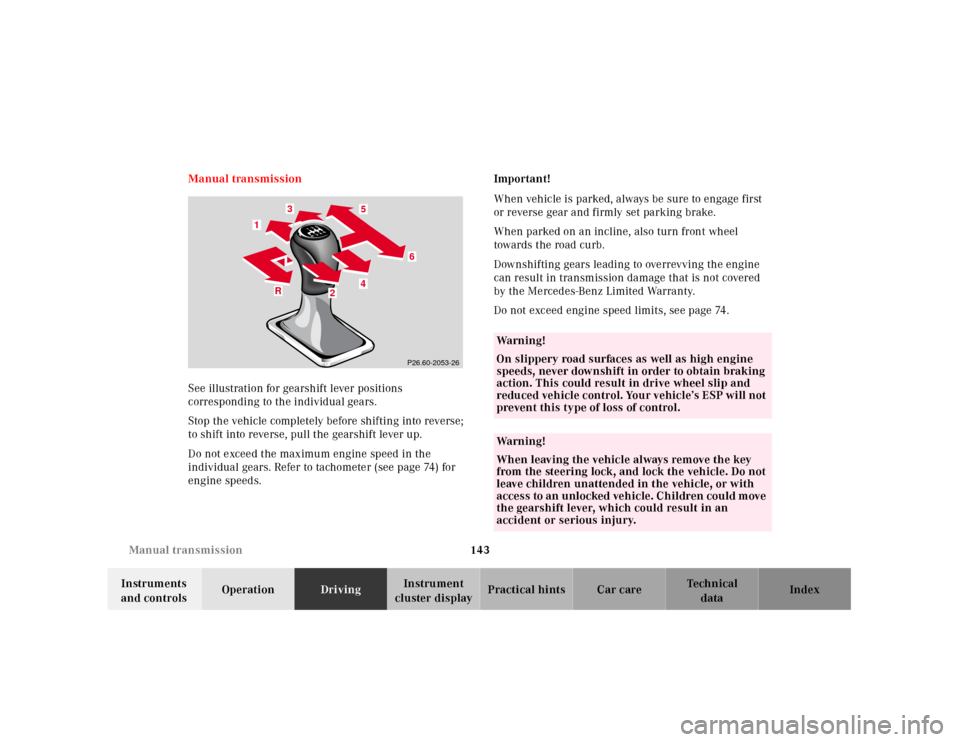
143 Manual transmission
Te ch n ica l
data Instruments
and controlsOperationDrivingInstrument
cluster displayPractical hints Car care Index Manual transmission
See illustration for gearshift lever positions
corresponding to the individual gears.
Stop the vehicle completely before shifting into reverse;
to shift into reverse, pull the gearshift lever up.
Do not exceed the maximum engine speed in the
individual gears. Refer to tachometer (see page 74) for
engine speeds.Important!
When vehicle is parked, always be sure to engage first
or reverse gear and firmly set parking brake.
When parked on an incline, also turn front wheel
towards the road curb.
Downshifting gears leading to overrevving the engine
can result in transmission damage that is not covered
by the Mercedes-Benz Limited Warranty.
Do not exceed engine speed limits, see page 74.
4 1
6
5
1
3
R
4
R4
6
13
5
2
2
P26.60-2053-26
Wa r n i n g !
On slippery road surfaces as well as high engine
speeds, never downshift in order to obtain braking
action. This could result in drive wheel slip and
reduced vehicle control. Your vehicle’s ESP will not
prevent this type of loss of control.Wa r n i n g !
When leaving the vehicle always remove the key
from the steering lock, and lock the vehicle. Do not
leave children unattended in the vehicle, or with
access to an u nlocked veh ic le. Ch ildren cou ld m ove
the gearshift lever, which could result in an
accident or serious injury.
Page 147 of 273
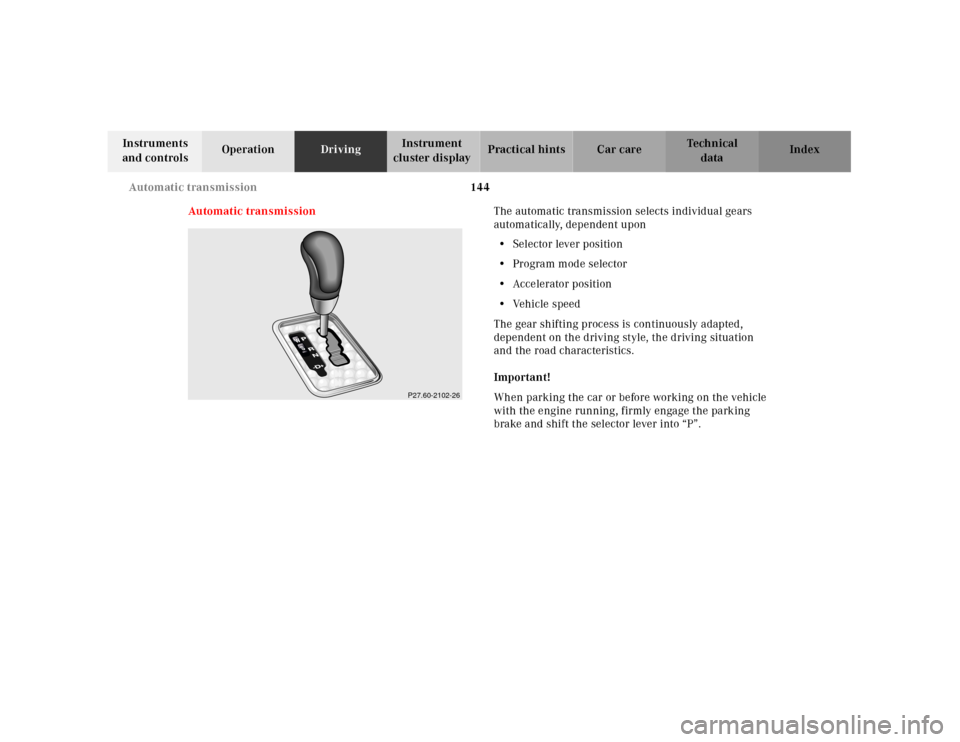
144 Automatic transmission
Te ch n ica l
data Instruments
and controlsOperationDrivingInstrument
cluster displayPractical hints Car care Index
Automatic transmissionThe automatic transmission selects individual gears
automatically, dependent upon
•Selector lever position
•Program mode selector
•Accelerator position
•Vehicle speed
The gear shifting process is continuously adapted,
dependent on the driving style, the driving situation
and the road characteristics.
Important!
When parking the car or before working on the vehicle
with the engine running, firmly engage the parking
brake and shift the selector lever into “P”.
�� @@
€€
ÀÀ
��
@@
€€
ÀÀ
��
@@
€€
ÀÀ
��
@@
€€
ÀÀ
��
@@
€€
ÀÀ
��
@@
€€
ÀÀ
��
@@
€€
ÀÀ
��
@@
€€
ÀÀ
��
@@
€€
ÀÀ
��
@@
€€
ÀÀ
��
@@
€€
ÀÀ
��
@@
€€
ÀÀ
��
@@
€€
ÀÀ
��
@@
€€
ÀÀ
��
@@
€€
ÀÀ
��
@@
€€
ÀÀ
��
@@
€€
ÀÀ
��
@@
€€
ÀÀ
��
@@
€€
ÀÀ
��
@@
€€
ÀÀ
��
@@
€€
ÀÀ
��
@@
€€
ÀÀ
��
@@
€€
ÀÀ
��
@@
€€
ÀÀ
��
@@
€€
ÀÀ
��
@@
€€
ÀÀ
��
@@
€€
ÀÀ
��
@@
€€
ÀÀ
��
@@
€€
ÀÀ
��
@@
€€
ÀÀ
��
@@
€€
ÀÀ
��
@@
€€
ÀÀ
��
@@
€€
ÀÀ
��
@@
€€
ÀÀ
��
@@
€€
ÀÀ
��
@@
€€
ÀÀ
��
@@
€€
ÀÀ
��
@@
€€
ÀÀ
��
@@
€€
ÀÀ
��
@@
€€
ÀÀ
��
@@
€€
ÀÀ
��
@@
€€
ÀÀ
��
@@
€€
ÀÀ
��
@@
€€
ÀÀ
��
@@
€€
ÀÀ
��
@@
€€
ÀÀ
��
@@
€€
ÀÀ
��
@@
€€
ÀÀ
��
@@
€€
ÀÀ
��
@@
€€
ÀÀ
��
@@
€€
ÀÀ
��
@@
€€
ÀÀ
��
@@
€€
ÀÀ
��
@@
€€
ÀÀ
��
@@
€€
ÀÀ
��
@@
€€
ÀÀ
��
@@
€€
ÀÀ
��
@@
€€
ÀÀ
��
@@
€€
ÀÀ
��
@@
€€
ÀÀ
��
@@
€€
ÀÀ
��
@@
€€
ÀÀ
��
@@
€€
ÀÀ
��
@@
€€
ÀÀ
��
@@
€€
ÀÀ
��
@@
€€
ÀÀ
��
@@
€€
ÀÀ
��
@@
€€
ÀÀ
��
@@
€€
ÀÀ
��
@@
€€
ÀÀ
��
@@
€€
ÀÀ
��
@@
€€
ÀÀ
��
@@
€€
ÀÀ
��
@@
€€
ÀÀ
��
@@
€€
ÀÀ
��
@@
€€
ÀÀ
��
@@
€€
ÀÀ
��
@@
€€
ÀÀ
��
@@
€€
ÀÀ
��
@@
€€
ÀÀ
��
@@
€€
ÀÀ
��
@@
€€
ÀÀ
��
@@
€€
ÀÀ
��
@@
€€
ÀÀ
��
@@
€€
ÀÀ
��
@@
€€
ÀÀ
��
@@
€€
ÀÀ
��
@@
€€
ÀÀ
��
@@
€€
ÀÀ
��
@@
€€
ÀÀ
��
@@
€€
ÀÀ
��
@@
€€
ÀÀ
��
@@
€€
ÀÀ
��
@@
€€
ÀÀ
��
@@
€€
ÀÀ
��
@@
€€
ÀÀ
��
@@
€€
ÀÀ
��
@@
€€
ÀÀ
��
@@
€€
ÀÀ
��
@@
€€
ÀÀ
��
@@
€€
ÀÀ
��
@@
€€
ÀÀ
��
@@
€€
ÀÀ
��
@@
€€
ÀÀ
��
@@
€€
ÀÀ
��
@@
€€
ÀÀ
��
@@
€€
ÀÀ
��
@@
€€
ÀÀ
��
@@
€€
ÀÀ
��
@@
€€
ÀÀ
��
@@
€€
ÀÀ
��
@@
€€
ÀÀ
��
@@
€€
ÀÀ
��
@@
€€
ÀÀ
��
@@
€€
ÀÀ
��
@@
€€
ÀÀ
��
@@
€€
ÀÀ
��
@@
€€
ÀÀ
��
@@
€€
ÀÀ
��
@@
€€
ÀÀ
��
@@
€€
ÀÀ
��
@@
€€
ÀÀ
��
@@
€€
ÀÀ
��
@@
€€
ÀÀ
��
@@
€€
ÀÀ
��
@@
€€
ÀÀ
��
@@
€€
ÀÀ
��
@@
€€
ÀÀ
��
@@
€€
ÀÀ
��
@@
€€
ÀÀ
��
@@
€€
ÀÀ
��
@@
€€
ÀÀ
��
@@
€€
ÀÀ
��
@@
€€
ÀÀ
��
@@
€€
ÀÀ
��
@@
€€
ÀÀ
��
@@
€€
ÀÀ
��
@@
€€
ÀÀ
��
@@
€€
ÀÀ
��
@@
€€
ÀÀ
��
@@
€€
ÀÀ
��
@@
€€
ÀÀ
��
@@
€€
ÀÀ
��
@@
€€
ÀÀ
��
@@
€€
ÀÀ
��
@@
€€
ÀÀ
��
@@
€€
ÀÀ
��
@@
€€
ÀÀ
��
@@
€€
ÀÀ
��
@@
€€
ÀÀ
��
@@
€€
ÀÀ
��
@@
€€
ÀÀ
��
@@
€€
ÀÀ
��
@@
€€
ÀÀ
��
@@
€€
ÀÀ
��
@@
€€
ÀÀ
��
@@
€€
ÀÀ
��
@@
€€
ÀÀ
��
@@
€€
ÀÀ
��
@@
€€
ÀÀ
��
@@
€€
ÀÀ
��
@@
€€
ÀÀ
��
@@
€€
ÀÀ
��
@@
€€
ÀÀ
��
@@
€€
ÀÀ
��
@@
€€
ÀÀ
��
@@
€€
ÀÀ
��
@@
€€
ÀÀ
��
@@
€€
ÀÀ
��
@@
€€
ÀÀ
��
@@
€€
ÀÀ
��
@@
€€
ÀÀ
��
@@
€€
ÀÀ
��
@@
€€
ÀÀ
��
@@
€€
ÀÀ
��
@@
€€
ÀÀ
��
@@
€€
ÀÀ
��
@@
€€
ÀÀ
��
@@
€€
ÀÀ
��
@@
€€
ÀÀ
��
@@
€€
ÀÀ
��
@@
€€
ÀÀ
��
@@
€€
ÀÀ
��
@@
€€
ÀÀ
��
@@
€€
ÀÀ
��
@@
€€
ÀÀ
��
@@
€€
ÀÀ
��
@@
€€
ÀÀ
��
@@
€€
ÀÀ
��
@@
€€
ÀÀ
��
@@
€€
ÀÀ
��
@@
€€
ÀÀ
��
@@
€€
ÀÀ
��
@@
€€
ÀÀ
��
@@
€€
ÀÀ
��
@@
€€
ÀÀ
��
@@
€€
ÀÀ
��
@@
€€
ÀÀ
��
@@
€€
ÀÀ
��
@@
€€
ÀÀ
��
@@
€€
ÀÀ
��
@@
€€
ÀÀ
��
@@
€€
ÀÀ
��
@@
€€
ÀÀ
��
@@
€€
ÀÀ
��
@@
€€
ÀÀ
��
@@
€€
ÀÀ
��
@@
€€
ÀÀ
��
@@
€€
ÀÀ
��
@@
€€
ÀÀ
��
@@
€€
ÀÀ
��
@@
€€
ÀÀ
��
@@
€€
ÀÀ
��
@@
€€
ÀÀ
��
@@
€€
ÀÀ
��
@@
€€
ÀÀ
��
@@
€€
ÀÀ
��
@@
€€
ÀÀ
��
@@
€€
ÀÀ
��
@@
€€
ÀÀ
��
@@
€€
ÀÀ
��
@@
€€
ÀÀ
��
@@
€€
ÀÀ
��
@@
€€
ÀÀ
��
@@
€€
ÀÀ
��
@@
€€
ÀÀ
��
@@
€€
ÀÀ
��
@@
€€
ÀÀ
��
@@
€€
ÀÀ
��
@@
€€
ÀÀ
��
@@
€€
ÀÀ
��
@@
€€
ÀÀ
��
@@
€€
ÀÀ
��
@@
€€
ÀÀ
��
@@
€€
ÀÀ
��
@@
€€
ÀÀ
��
@@
€€
ÀÀ
��
@@
€€
ÀÀ
��
@@
€€
ÀÀ
��
@@
€€
ÀÀ
��
@@
€€
ÀÀ
��
@@
€€
ÀÀ
��
@@
€€
ÀÀ
��
@@
€€
ÀÀ
��
@@
€€
ÀÀ
��
@@
€€
ÀÀ
��
@@
€€
ÀÀ
��
@@
€€
ÀÀ
��
@@
€€
ÀÀ
��
@@
€€
ÀÀ
��
@@
€€
ÀÀ
��
@@
€€
ÀÀ
��
@@
€€
ÀÀ
��
@@
€€
ÀÀ
��
@@
€€
ÀÀ
��
@@
€€
ÀÀ
��
@@
€€
ÀÀ
��
@@
€€
ÀÀ
��
@@
€€
ÀÀ
��
@@
€€
ÀÀ
��
@@
€€
ÀÀ
��
@@
€€
ÀÀ
��
@@
€€
ÀÀ
��
@@
€€
ÀÀ
��
@@
€€
ÀÀ
��
@@
€€
ÀÀ
��
@@
€€
ÀÀ
��
@@
€€
ÀÀ
��
@@
€€
ÀÀ
��
@@
€€
ÀÀ
��
@@
€€
ÀÀ
��
@@
€€
ÀÀ
��
@@
€€
ÀÀ
��
@@
€€
ÀÀ
��
@@
€€
ÀÀ
��
@@
€€
ÀÀ
��
@@
€€
ÀÀ
��
@@
€€
ÀÀ
��
@@
€€
ÀÀ
��
@@
€€
ÀÀ
��
@@
€€
ÀÀ
��
@@
€€
ÀÀ
��
@@
€€
ÀÀ
��
@@
€€
ÀÀ
��
@@
€€
ÀÀ
��
@@
€€
ÀÀ
��
@@
€€
ÀÀ
��
@@
€€
ÀÀ
��
@@
€€
ÀÀ
��
@@
€€
ÀÀ
��
@@
€€
ÀÀ
��
@@
€€
ÀÀ
��
@@
€€
ÀÀ
��
@@
€€
ÀÀ
��
@@
€€
ÀÀ
��
@@
€€
ÀÀ
��
@@
€€
ÀÀ
��
@@
€€
ÀÀ
��
@@
€€
ÀÀ
��
@@
€€
ÀÀ
��
@@
€€
ÀÀ
��
@@
€€
ÀÀ
��
@@
€€
ÀÀ
��
@@
€€
ÀÀ
��
@@
€€
ÀÀ
��
@@
€€
ÀÀ
��
@@
€€
ÀÀ
��
@@
€€
ÀÀ
��
@@
€€
ÀÀ
��
@@
€€
ÀÀ
��
@@
€€
ÀÀ
��
@@
€€
ÀÀ
��
@@
€€
ÀÀ
��
@@
€€
ÀÀ
��
@@
€€
ÀÀ
��
@@
€€
ÀÀ
��
@@
€€
ÀÀ
��
@@
€€
ÀÀ
��
@@
€€
ÀÀ
��
@@
€€
ÀÀ
��
@@
€€
ÀÀ
��
@@
€€
ÀÀ
��
@@
€€
ÀÀ
��
@@
€€
ÀÀ
��
@@
€€
ÀÀ
��
@@
€€
ÀÀ
��
@@
€€
ÀÀ
��
@@
€€
ÀÀ
��
@@
€€
ÀÀ
��
@@
€€
ÀÀ
��
@@
€€
ÀÀ
��
@@
€€
ÀÀ
��
@@
€€
ÀÀ
��
@@
€€
ÀÀ
��
@@
€€
ÀÀ
��
@@
€€
ÀÀ
��
@@
€€
ÀÀ
��
@@
€€
ÀÀ
��
@@
€€
ÀÀ
��
@@
€€
ÀÀ
��
@@
€€
ÀÀ
��
@@
€€
ÀÀ
��
@@
€€
ÀÀ
��
@@
€€
ÀÀ
��
@@
€€
ÀÀ
��
@@
€€
ÀÀ
��
@@
€€
ÀÀ
��
@@
€€
ÀÀ
��
@@
€€
ÀÀ
��
@@
€€
ÀÀ
��
@@
€€
ÀÀ
��
@@
€€
ÀÀ
��
@@
€€
ÀÀ
��
@@
€€
ÀÀ
��
@@
€€
ÀÀ
��
@@
€€
ÀÀ
��
@@
€€
ÀÀ
��
@@
€€
ÀÀ
��
@@
€€
ÀÀ
��
@@
€€
ÀÀ
��
@@
€€
ÀÀ
��
@@
€€
ÀÀ
��
@@
€€
ÀÀ
��
@@
€€
ÀÀ
��
yy
P27.60-2102-26
Page 148 of 273
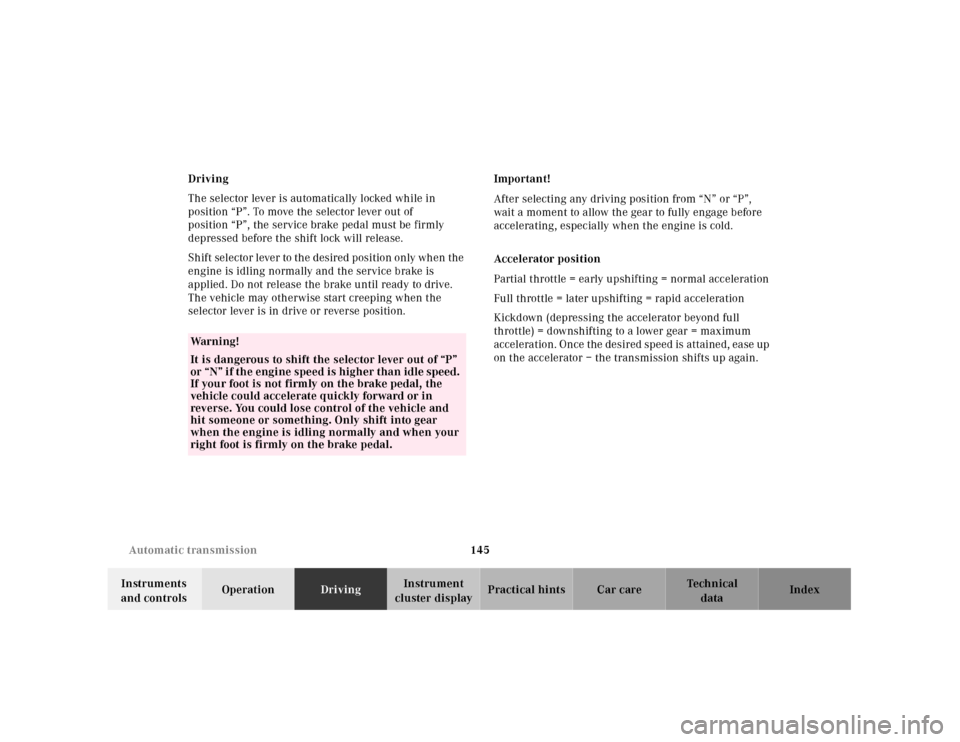
145 Automatic transmission
Te ch n ica l
data Instruments
and controlsOperationDrivingInstrument
cluster displayPractical hints Car care Index Driving
The selector lever is automatically locked while in
position “P”. To move the selector lever out of
position “P”, the service brake pedal must be firmly
depressed before the shift lock will release.
Shift selector lever to the desired position only when the
engine is idling normally and the service brake is
applied. Do not release the brake until ready to drive.
The vehicle may otherwise start creeping when the
selector lever is in drive or reverse position.Important!
After selecting any driving position from “N” or “P”,
wait a moment to allow the gear to fully engage before
accelerating, especially when the engine is cold.
Accelerator position
Partial throttle = early upshifting = normal acceleration
Full throttle = later upshifting = rapid acceleration
Kickdown (depressing the accelerator beyond full
throttle) = downshifting to a lower gear = maximum
acceleration. Once the desired speed is attained, ease up
on the accelerator – the transmission shifts up again.
Wa r n i n g !
It is dangerous to shift the selector lever out of “P”
or “N” if the engine speed is higher than idle speed.
If your foot is not firmly on the brake pedal, the
vehicle could accelerate quickly forward or in
reverse. You could lose control of the vehicle and
hit someone or something. Only shift into gear
when the engine is idling normally and when your
right foot is firmly on the brake pedal.
Page 149 of 273
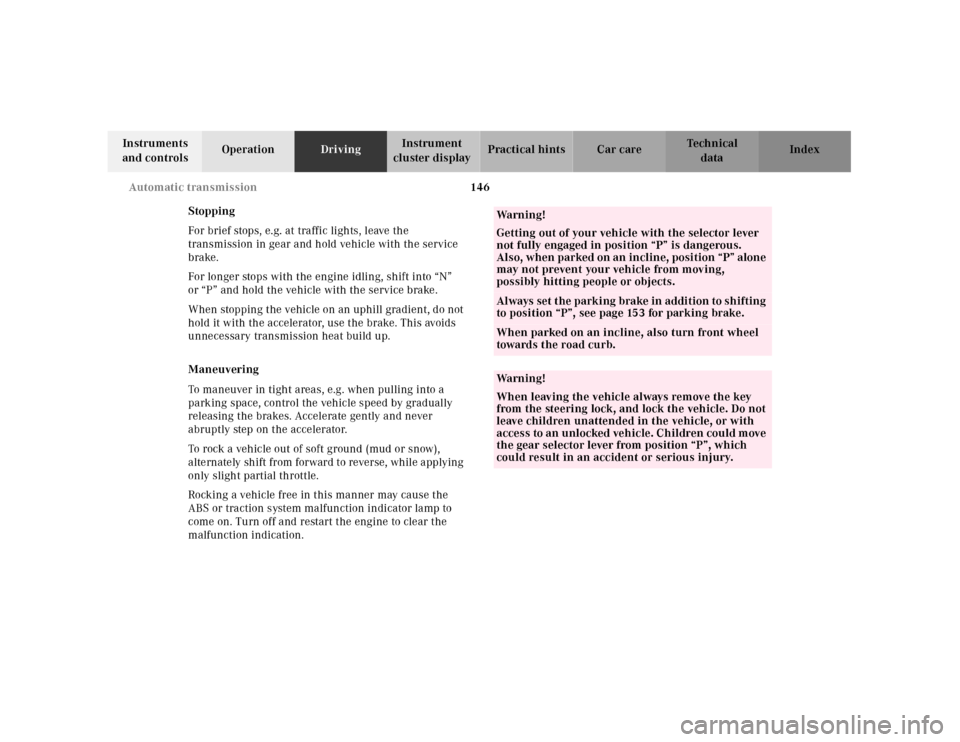
146 Automatic transmission
Te ch n ica l
data Instruments
and controlsOperationDrivingInstrument
cluster displayPractical hints Car care Index
Stopping
For brief stops, e.g. at traffic lights, leave the
transmission in gear and hold vehicle with the service
brake.
For longer stops with the engine idling, shift into “N”
or “P” and hold the vehicle with the service brake.
When stopping the vehicle on an uphill gradient, do not
hold it with the accelerator, use the brake. This avoids
unnecessary transmission heat build up.
Maneuvering
To maneuver in tight areas, e.g. when pulling into a
parking space, control the vehicle speed by gradually
releasing the brakes. Accelerate gently and never
abruptly step on the accelerator.
To rock a vehicle out of soft ground (mud or snow),
alternately shift from forward to reverse, while applying
only slight partial throttle.
Rocking a vehicle free in this manner may cause the
ABS or traction system malfunction indicator lamp to
come on. Turn off and restart the engine to clear the
malfunction indication.
Wa r n i n g !
Getting out of your vehicle with the selector lever
not fully engaged in position “P” is dangerous.
Also, when parked on an incline, posi tion “P” alone
may not prevent your vehicle from moving,
possibly hitting people or objects.Always set t he parki ng brake in addi tion to sh ifting
to position “P”, see page 153 for parking brake. When parked on an incline, also turn front wheel
towards the road curb.Wa r n i n g !
When leaving the vehicle always remove the key
from the steering lock, and lock the vehicle. Do not
leave children unattended in the vehicle, or with
access to an u nlocked veh ic le. Ch ildren cou ld m ove
the gear selector lever from position “P”, which
could result in an accident or serious injury.
Page 150 of 273
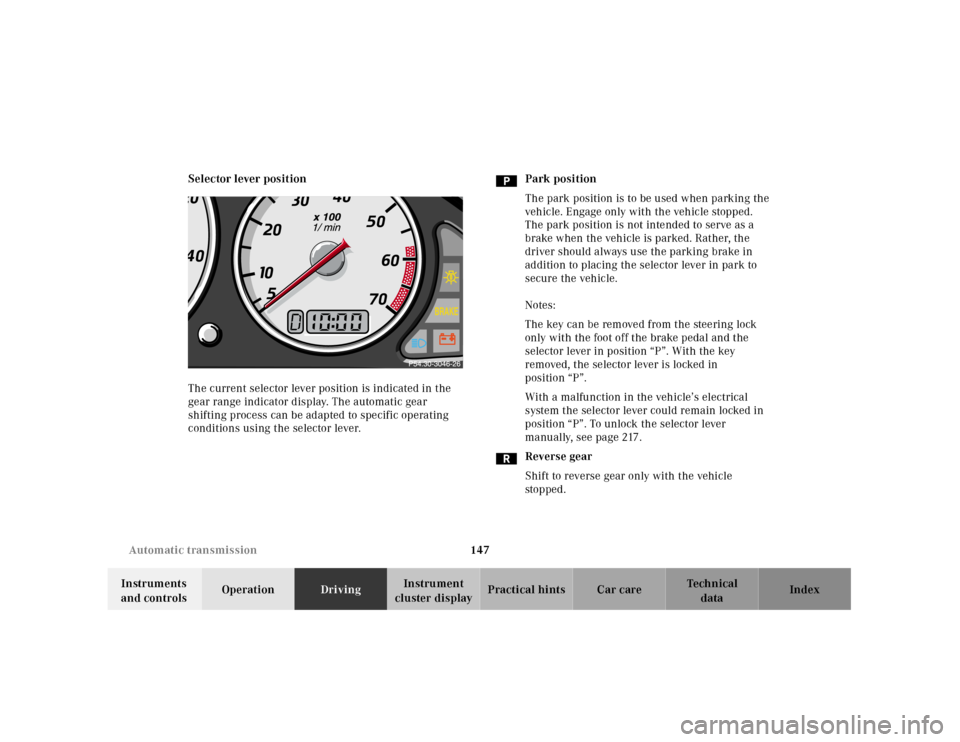
147 Automatic transmission
Te ch n ica l
data Instruments
and controlsOperationDrivingInstrument
cluster displayPractical hints Car care Index Selector lever position
The current selector lever position is indicated in the
gear range indicator display. The automatic gear
shifting process can be adapted to specific operating
conditions using the selector lever.Park position
The park position is to be used when parking the
vehicle. Engage only with the vehicle stopped.
The park position is not intended to serve as a
brake when the vehicle is parked. Rather, the
driver should always use the parking brake in
addition to placing the selector lever in park to
secure the vehicle.
Notes:
The key can be removed from the steering lock
only with the foot off the brake pedal and the
selector lever in position “P”. With the key
removed, the selector lever is locked in
position “P”.
With a malfunction in the vehicle’s electrical
system the selector lever could remain locked in
position “P”. To unlock the selector lever
manually, see page 217.
Reverse gear
Shift to reverse gear only with the vehicle
sto p ped .